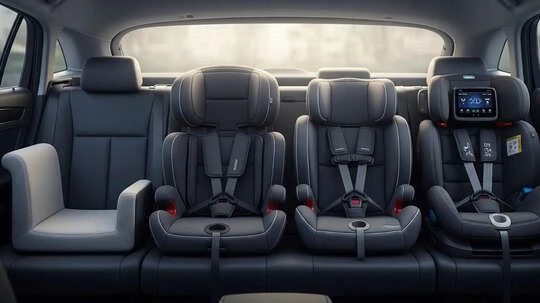For anyone curious about cars but still learning the ropes, understanding how we keep children safe during travel is a great starting point.
A crucial part of that safety puzzle is something called ISOFIX. While it may sound technical, it’s actually a simple and brilliant innovation designed to protect our youngest passengers.
What is ISOFIX?
ISOFIX stands for International Standards Organisation FIX, and it’s a global system that makes it easier and safer to install child car seats. Traditionally, parents had to use seat belts to strap child seats into cars – a method that often left room for error. If not done exactly right, the seat might shift during a sudden stop or crash, putting the child at risk.
With ISOFIX, this problem is almost eliminated. The system uses two solid metal clips on the child seat that click into matching anchor points built into the car’s back seat. This forms a firm and fixed connection between the seat and the car, which greatly reduces movement and increases protection. Some models also include a top tether strap or a support leg for extra stability.
What’s great is that many ISOFIX systems come with color indicators or click sounds to show when the seat is properly attached – so even first-time parents can be confident the installation is correct.
Why ISOFIX is Safer and Smarter
The key reason ISOFIX is so popular is safety through simplicity. Here’s why it works so well:
- No complicated seatbelt threading: It removes the chance of buckling incorrectly.
- Firm fit to the car: The seat becomes almost a part of the vehicle itself, reducing movement in sudden stops or collisions.
- More stability: Especially useful on bumpy roads – no wobbling or sliding.
- Quick installation: Saves time and gives peace of mind.
Car companies and child seat makers agree that ISOFIX helps eliminate one of the biggest risks: incorrect seat installation.
How to Keep Children Safe in a Car
Now that you understand ISOFIX, it’s important to know how to protect children overall during car travel:
- Use the Right Seat for Their Age and Size: Infants need rear-facing seats, toddlers can shift to forward-facing, and older children require booster seats until they’re big enough to use regular seat belts safely.
- Install It Properly: Whether you’re using ISOFIX or a seatbelt-secured seat, read both the seat’s manual and your car’s manual to make sure everything lines up correctly.
- Back Seat is Best: Children under 13 should always ride in the back. It’s the safest place, especially in a crash.
- Use the Harness Properly: The harness should be snug, with no twists. For rear-facing seats, the harness should sit at or below the shoulders; for forward-facing, it should be at or above.
- Keep Rear-Facing Longer: Rear-facing seats protect the head, neck, and spine better in crashes, especially frontal ones. Keep your child rear-facing as long as the seat allows.
- Don’t Use Expired or Damaged Seats: Car seats have expiration dates and may be unsafe if they’ve been in a crash or recalled.
- Never Leave a Child Alone in a Car: Even for a few minutes. Heat, suffocation, and other dangers can develop quickly.
The Evolution of Child Seat Belts in Cars
It’s fascinating how far we’ve come in terms of child safety in vehicles. Here’s a quick history:
- 1930s: Early car seats were more like booster chairs that let kids look out the window – they weren’t designed for safety.
- 1960s: The first real safety-focused car seats appeared. These had proper buckles and metal frames.
- 1970s: The U.S. government introduced federal safety standards for child car seats. Countries around the world began following suit.
- 1980s-90s: Major improvements included five-point harnesses, stricter laws, and crash testing for child seats.
- 2000s: ISOFIX/LATCH systems were introduced globally, allowing safer and easier installation.
- Today: Modern car seats come with advanced features like side-impact protection, energy-absorbing materials, and even smart technology that alerts if the seat isn’t buckled or if a child is left inside.
In places like Europe, new rules like i-Size (R129) now focus more on height-based categories and recommend longer use of rear-facing seats, as science proves they offer better protection for young children.
Child safety in cars has come a long way – from simple booster cushions to high-tech safety cocoons. ISOFIX is one of the most important advances in this journey, making it easier and faster for parents to secure car seats properly, even without experience.
Whether you’re a parent, a curious teen learning about cars, or just an auto enthusiast dipping your toes in the topic, knowing how ISOFIX works is a small step that opens the door to a big world of safety and smart design.
So, the next time you see a car seat with metal clips or hear a “click” as it locks into place – remember, that tiny sound could be saving a life.
